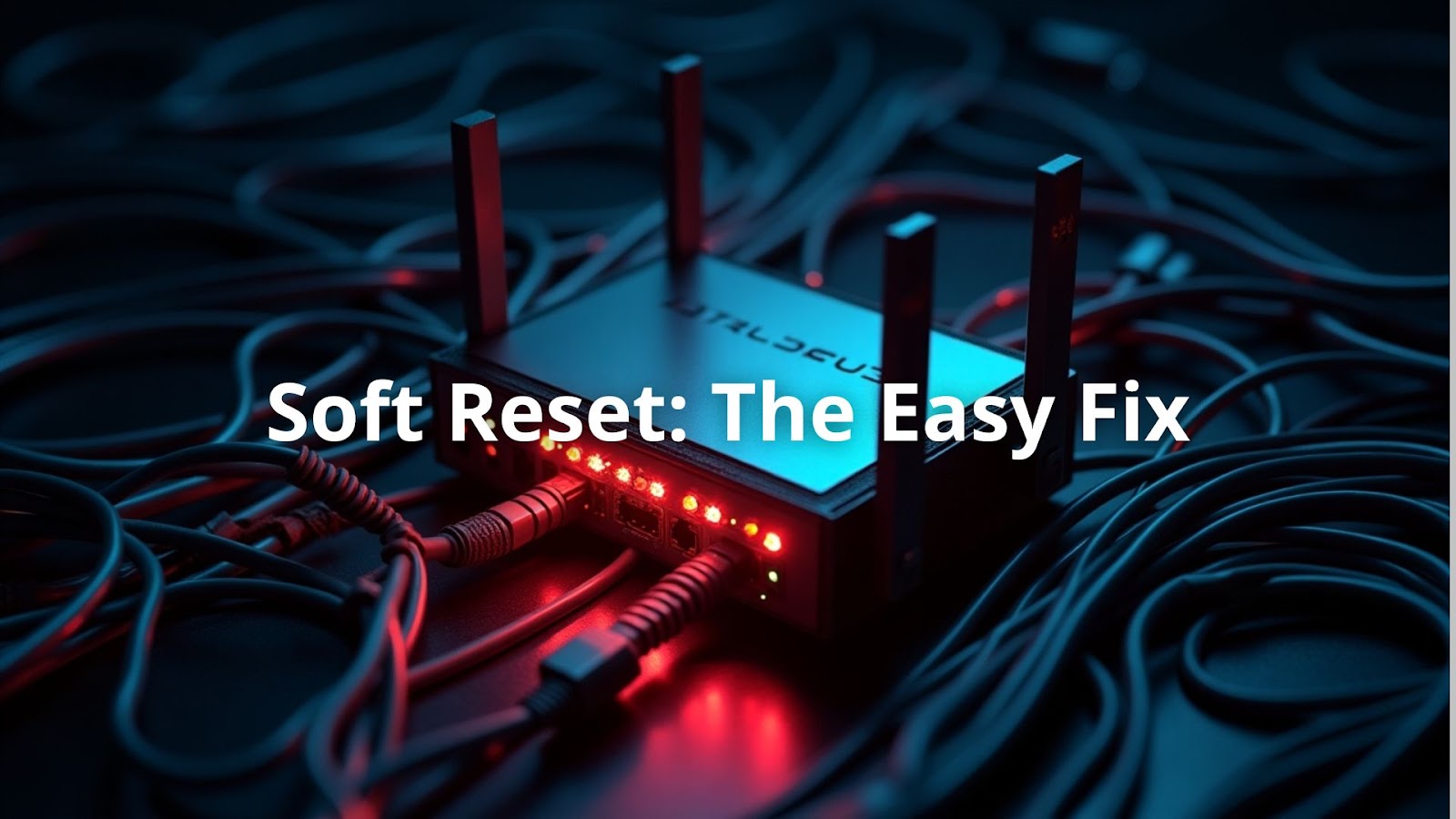Resetting a 5G internet router can feel like a simple solution to frustrating slow connections. There are two main ways to reset a router: a soft reset and a factory reset. Each method serves a different purpose and can help solve various issues. Knowing how to reset a router can lead to a stable and fast internet connection. Understanding these methods can make a big difference in online experiences. Keep reading to learn the steps to reset a router effectively and improve internet performance.
Key Takeaway
- A soft reset is like rebooting your computer without losing settings.
- A factory reset erases all settings, returning to original settings.
- Always have your ISP information ready for reconfiguration after resetting.
Understanding Your 5G Home Internet
5G home internet offers high-speed access without the hassle of wires. It uses advanced 5G technology, making it faster than older internet types (1). However, there are factors that can affect performance. Here are some tips to improve the connection:
- Place the Router Wisely: The router should be in a spot where walls or furniture don’t block the signal.
- Check Device Compatibility: Some older devices may not work well with 5G, slowing down the experience.
- Use a 5G Modem or Router: Without the right equipment, speeds may not reach their full potential.
Setting up 5G home internet requires attention to detail. Knowing how to optimize the setup ensures everything works together for the best experience.
Soft Reset: The Easy Fix

Sometimes, a router just needs a little nap. A soft reset can refresh its memory. This simple fix can solve minor issues without changing any settings. It’s a good first step when things aren’t working right.
- Unplug the Router: Disconnect it from the power source.
- Wait: Leave it unplugged for about 30 seconds.
- Plug it Back In: Reconnect the power cable and wait for it to restart.
After a soft reset, the internet might feel faster. It’s like the router got a fresh start. This quick fix can save time and frustration. If the internet still feels slow, other issues might be at play (2). If you're looking for a reliable connection without the hassle of cables, check out Cliq Mobile's Fixed Wireless Access (FWA) for fast and seamless internet.
Factory Reset: When Things Go Wrong
Credits: NetWork From Home
Resetting a router can feel like a big task, but it’s really just a few simple steps. Here’s how to do it:
- Find the Reset Button: Look for a tiny button on the back or bottom of the router. A paper clip works well to press it.
- Press and Hold: Press that button for about 10 to 30 seconds. The lights on the router will blink or change colors, showing that something’s happening.
- Wait for Reboot: Let the router restart completely. This might take a few minutes.
When it’s finished, everything will be wiped clean. The Wi-Fi name and password will be gone too, so it’s best to do this only when needed. After a reset, setting everything back up can feel like cleaning a messy room. It takes time, but it’s worth it for a fresh start.
Practical advice: Always write down your Wi-Fi details before resetting.
Reconfigure Your Router: Setting Up Again
After resetting a router, it’s time to piece everything back together. Here’s how to do it step-by-step:
- Connect to the Router: Use an Ethernet cable or Wi-Fi. Look for the default network name (SSID) and password, usually printed on a sticker on the router.
- Access Router Settings: Open a web browser and type the router’s IP address, like 192.168.1.1 or 192.168.0.1.
- Log in Using Default Credentials: Check that sticker again for the username and password needed to get inside.
- Set Up Your Network: Follow the prompts or set it up manually. You’ll want to:
- Change the SSID (the name of your network)
- Create a new password
- Adjust security settings (WPA2 is a smart choice)
- Save Settings: Don’t forget to save everything before leaving the setup page.
Setting up a router can feel like a puzzle, but you can avoid the hassle with Cliq Mobile's Fixed Wireless Access (FWA)—just plug in the modem and get online within minutes.
Important Considerations: What to Remember
Setting up a router can feel a bit tricky, but some simple things can help. Having the internet service provider (ISP) information ready is smart. This includes details like the account number and any passwords needed to set everything back up.
Next, it’s wise to check for a firmware update after the reset. This software helps the router run better and keeps it safe from threats. If the router has both 2.4GHz and 5GHz bands, turning one off during setup might make connecting easier.
Here’s a quick list to remember:
- Have ISP Information Ready: Account number and passwords can be helpful.
- Check for Firmware Updates: Keeping the router’s software up to date helps with performance.
- Adjust Network Band Settings: Turning off one band can simplify the connection process.
Struggling with setup? Skip the frustration and switch to Cliq Mobile’s Fixed Wireless Access (FWA)—a fast, reliable internet option with no complex wiring.
Cliq Mobile: Fixed Wireless Access (FWA) Service
Fast internet without the hassle of cables? That’s what Cliq Mobile’s FWA service offers. Using wireless signals from base stations, it delivers high-speed internet to homes and small businesses—no fibre, no complex wiring.
Pros
- Ultra-Fast Speeds – 5G technology makes it feel like fibre, with smooth streaming and quick downloads.
- Easy Setup – Just plug in the modem/router, and you're online in minutes.
- Flexible Coverage – Works in areas where traditional broadband isn’t an option.
- Reliable Connection – Handles gaming, streaming, and remote work with ease.
- Cost-Effective – Competitive pricing, no hidden fees.
Cons
- Limited Availability – Some areas may not have coverage yet.
- Base Station Dependency – Service may be affected by maintenance or outages.
- Signal Interference – Physical barriers can reduce speeds.
Dealbreaker: Those needing frequent assistance might find support lacking.
Best For: Families, remote workers, and small businesses in underserved areas who need fast, stable, and easy-to-set-up internet.
Troubleshooting Tips: If Things Still Aren’t Working

After a router reset, it can be frustrating when the internet still doesn’t work right. But there are some troubleshooting steps that can help clear up the issue.
First, checking the LED indicators is a good start. These little lights can tell a lot about what’s going on. If some lights are off or blinking in strange ways, that might be a sign to look deeper into the problem.
Next, testing the connection is important. Running connectivity tests can show if devices are connecting as they should. Sometimes, it’s just a matter of resetting one device instead of the whole system.
Also, wireless interference can be a sneaky culprit. Other devices can mess with signal strength. If there are many wireless devices around, moving them further away from the router might help.
Here’s a quick list of steps:
- Check LED Indicators: Look for unusual lights or patterns.
- Test Your Connection: Run tests to see if devices are connecting properly.
- Look for Wireless Interference: Move other devices away if needed.
Practical advice: Keeping the area around the router clear can help maintain a strong signal.
FAQ
Why would I need to factory reset my 5G router?
You might need a factory reset when facing persistent connectivity problems or forgetting admin credentials. This restores default settings, clearing any customized network configuration. It can fix slow internet speed and connection stability issues. Remember, a factory reset erases all personal settings including Wi-Fi passwords. Try a simple power cycle first, as this less drastic step might solve your problem.
How do I perform a router reset using the reset button?
Most 5G routers have a small reset button on the back or bottom. Use a paperclip to press and hold this button for 10-30 seconds until the LED indicators flash. This restores default settings and clears your wireless network configuration. After resetting, reconfigure your network using the login credentials found in your router manual. This method helps when you can't access the admin interface.
What's the difference between a power cycle and a factory reset?
A power cycle (modem reboot) simply turns your 5G router off and on, refreshing your internet connection without changing settings. This often fixes temporary connectivity problems. A factory reset erases all customized settings, returning your router to its original default settings. Power cycling preserves your wireless network setup, making it the recommended first troubleshooting step before attempting a complete router reset.
How can I reset my 5G router through the admin interface?
Connect to your router via Ethernet or Wi-Fi. Enter your router's IP address in a web browser (typically 192.168.0.1). Log in with your device credentials. Navigate to device management or system restore. Select the reset option from the settings menu. This method offers more control than the physical reset button, letting you choose between partial or complete reset of network configuration options.
What should I do after resetting my 5G router?
After a router reset, reconfigure your wireless security settings and internet connection. Access the admin interface using default credentials from the router manual. Set a new Wi-Fi password and network name. Configure your broadband settings according to your ISP settings. Adjust DHCP, NAT, and QoS settings as needed. Finally, reconnect all your wireless devices to the new network.
Why isn't my internet working after resetting my 5G router?
Check all physical connections and LED indicators. Verify you've correctly configured your ISP settings in the admin interface. Run network diagnostics to identify specific issues. Your device firmware might need updating, or signal interference could be affecting connection stability. Try changing Wi-Fi channels to reduce wireless interference. If problems persist, contact your ISP support.
How can I optimize my network performance after resetting my 5G router?
Place your router strategically for maximum signal strength. Update your device firmware. Choose appropriate Wi-Fi channels to minimize interference. Adjust QoS settings to prioritize important traffic. Use Ethernet connections for bandwidth-intensive devices. Run internet speed tests to verify improvements, and adjust network adapter settings for optimal device compatibility with your 5G router.
.webp)


.webp)